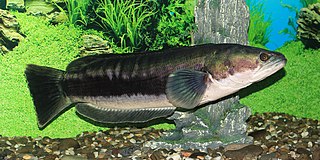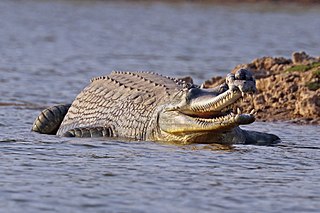
Channa is a genus of predatory fish in the family Channidae, commonly known as snakeheads, native to freshwater habitats in Asia. This genus contains about 50 scientifically described species. The genus has a wide natural distribution extending from Iraq in the west, to Indonesia and China in the east, and parts of Siberia in the Far East. A particularly high richness of species exists in Myanmar (Burma) and northeastern India, and many Channa species live nowhere else. In contrast, a few widespread species have been introduced to several regions outside their natural range, where they often become invasive. The large and medium-sized Channa species are among the most common staple food fish in several Asian countries, and they are extensively cultured. Apart from their importance as a food fish, snakeheads are consumed in some regions as a traditional medicine for wound healing and reducing postoperative pain and discomfort, and collected for the international aquarium pet trade.

The gharial, also known as gavial or fish-eating crocodile, is a crocodilian in the family Gavialidae and among the longest of all living crocodilians. Mature females are 2.6 to 4.5 m long, and males 3 to 6 m. Adult males have a distinct boss at the end of the snout, which resembles an earthenware pot known as a ghara, hence the name "gharial". The gharial is well adapted to catching fish because of its long, narrow snout and 110 sharp, interlocking teeth.

The Alaotra grebe, also known as Delacour's little grebe or rusty grebe, is a recently extinct grebe that was endemic to Lake Alaotra and its surrounding lakes in Madagascar. Experts say that the grebe became extinct after carnivorous fish were introduced into its native habitat.
The Borna snakehead, or Chel snakehead, Channa amphibeus, is an extremely rare species of snakehead. C. amphibeus is native only to the Chel River, of the Bhutan foothills, in northern Bengal, India.

Channa bleheri is a species of dwarf snakehead that is endemic to the Brahmaputra River basin in the Indian states of Assam and Arunachal Pradesh. It is among the most colorful species of snakehead.

Dwarf snakehead is a term coined by aquarists to describe a group of Channa snakehead fishes growing to about 25 cm (10 in) maximum. They are found in freshwater habitats in South and Southeast Asia, and southern China.

Channa gachua, the dwarf snakehead, is a species of fish in the family Channidae. The name "dwarf snakehead" is also used for several other species of small snakeheads. C. gachua is native to freshwater habitats in southern Asia, where it has a wide distribution from Iran to Indonesia. This fish is considered to be a species complex, a group of several closely related taxa with one name. It is likely at least three to four different species, and further research may differentiate them. A few species such as Channa harcourtbutleri have been separated from the complex in recent decades. The easternmost population of C. gachua is often recognized as a separate species C. limbata, while the isolated Sri Lankan population often is recognized as C. kelaartii.

Channa striata, the striped snakehead, is a species of snakehead fish. It is also known as the common snakehead, chevron snakehead, or snakehead murrel and generally referred simply as mudfish. It is native to South and Southeast Asia, and has been introduced to some Pacific Islands. Reports from Madagascar and Hawaii are misidentifications of C. maculata.

The Brahmaputra Valley semi-evergreen forests is a tropical moist broadleaf forest ecoregion of Northeastern India, southern Bhutan and adjacent Bangladesh.

The orange-spotted snakehead is a species of snakehead fish. Its body is of brownish colour intermixed with vertical orange stripes. Males have taller dorsal fins with more intense coloration, and narrower heads. It is endemic to Brahmaputra River basin. Its type locality is Dibrugarh, the most northeastern area of Assam, India. Dibrughar is the same type locality as that of Channa bleheri.
Channa burmanica is a species of snakehead which is endemic to northern Burma. It is a very small species of snakehead included in the informal group of dwarf snakeheads. Its colouring closely resembles that of Channa gachua and Channa bleheri. It is very rarely found in pet shops. It is also considered to be a mouthbrooder species, though no successful breeding has yet occurred.
Channa harcourtbutleri, the Burmese snakehead, is a species of snakehead endemic to Inle Lake and surroundings in Myanmar. Locally called nga ohn-ma, among aquarists it is considered one of the dwarf snakeheads, but no significant import for aquarists is known. It is one of the smaller species of snakehead and has a standard length of up to 19.4 cm (7.6 in). The specific name honors Sir Harcourt Butler, a British governor in the region.

The swamp francolin, also called swamp partridge, is a francolin species native to the foothills of the Himalayas in northern India and Nepal. It is considered extinct in the Ganges-Brahmaputra delta in Bangladesh. It is listed as Vulnerable on the IUCN Red List.

The white-bellied heron also known as the imperial heron or great white-bellied heron, is a large heron species living in the foothills of the eastern Himalayas in northeast India and Bhutan to northern Myanmar. It inhabits undisturbed rivers and wetlands. It has been listed as Critically Endangered on the IUCN Red List since 2007, because the global population is estimated at less than 300 mature individuals and threatened by habitat loss and human disturbance. It is mostly dark grey with a white throat and underparts.

Channa marulius is a large species of snakehead native to South Asia. Populations in Southeast Asia are now regarded as separate species.

Oreichthys cosuatis is a small cyprinid fish found in India and Bangladesh.In India it is found along the ganga and brahmaputra river drainage in the states of West bengal and odisha It is also reported from Thailand and Myanmar.

The Malabar snakehead is a vulnerable species of snakehead from fresh water in the Western Ghats in India. Until 2011, its scientific name was usually considered to be a synonym of C. micropeltes, the giant snakehead.

Channa punctata, the spotted snakehead, is a species of snakehead. It is found in the Indian Subcontinent and nearby areas, ranging across Afghanistan, Pakistan, India, Sri Lanka, Nepal, Bangladesh, Myanmar and Tibet. Its natural habitats are swamps, ponds and brackish water systems. It is a fish of high food value and has little value as aquarium fish.
Channa stewartii is a species of dwarf snakehead in the family Channidae, which is native to Nepal and the Indian states of Arunachal Pradesh, Assam, Manipur, Meghalaya, Nagaland and Tripura. It may also be found in Bangladesh. This freshwater fish mostly inhabits hill streams, but can also be found in ponds. It is of little value as a food fish but common in the aquarium trade.

Aenigmachanna gollum, the Gollum snakehead, is a species of aquifer-dwelling dragon snakehead fish that is endemic to the Indian state of Kerala.
















